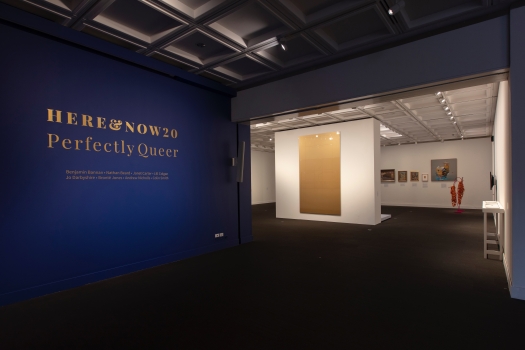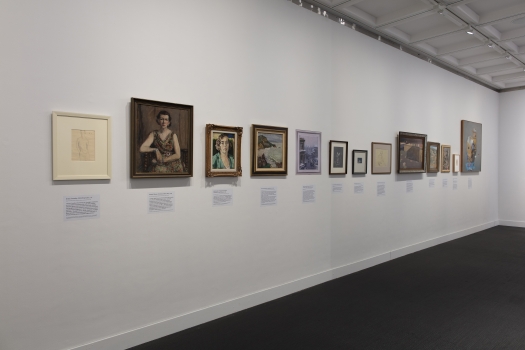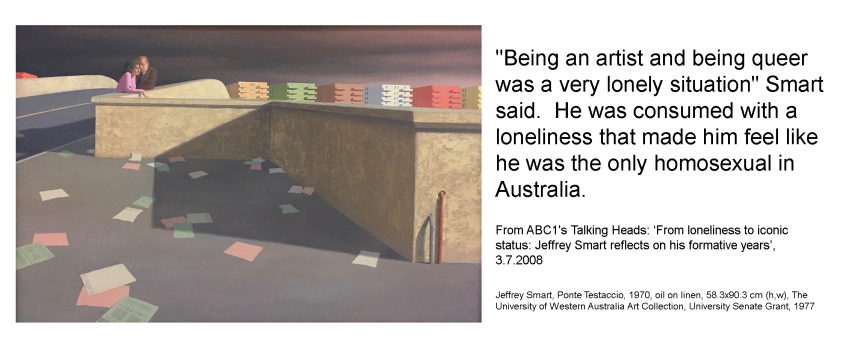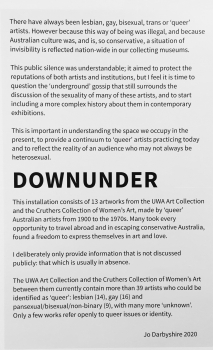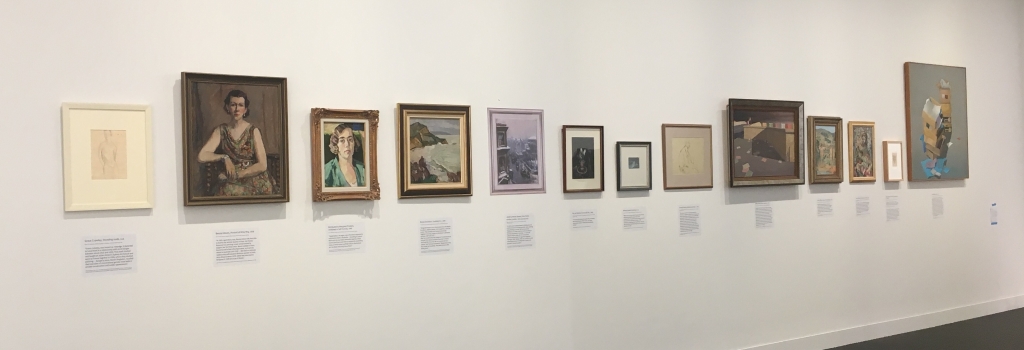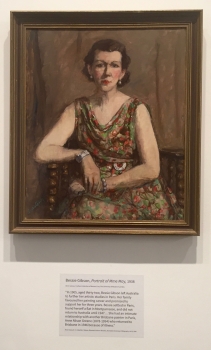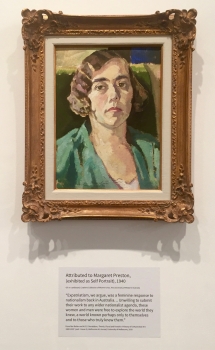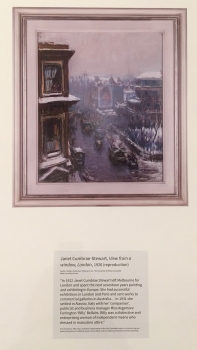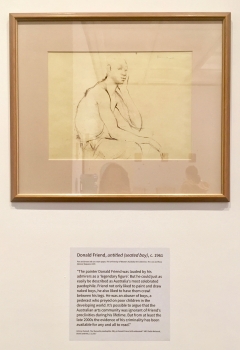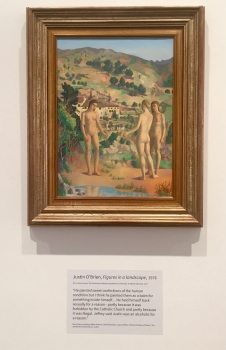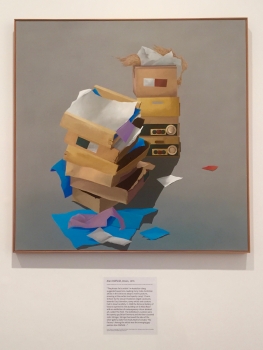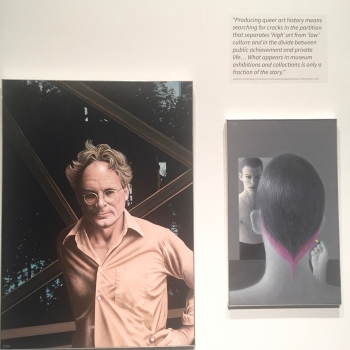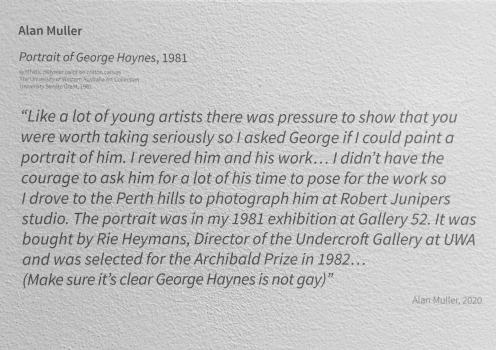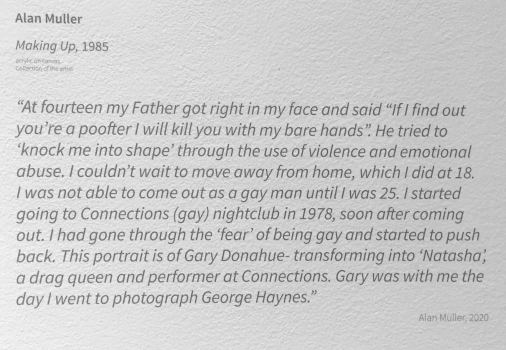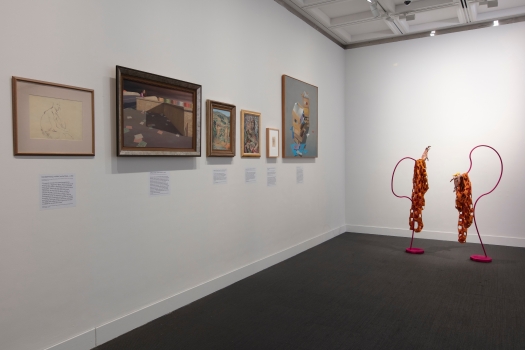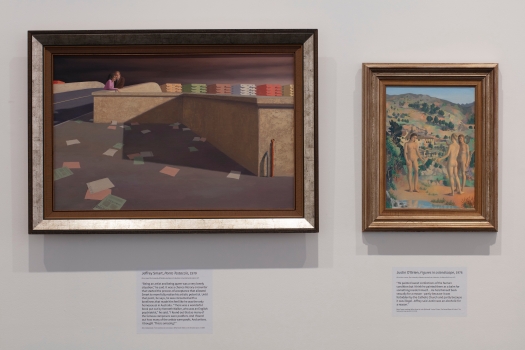HERE&NOW20: Perfectly Queer
29 August - 5 December 2020
Lawrence Wilson Art Gallery, University of WA
Catalogue can be dowloded here: https://www.uwa.edu.
Downunder
In this time when queer identity is becoming mainstream and there is no longer, in Western art galleries at least, the need to conceal what was once ‘unspeakable’, what do we gain from questioning past collection strategies?
It is courageous of museums to welcome what is by necessity a critical exercise but it also opens up curatorial practice to create exhibitions in museums that reflect social paradigm shifts.
My aim for this exhibition was to explore the University of Western Australia Art Collection and the Cruthers Collection of Women's Art; to try to identify queer (LGBTQ) artists and work about queer issues, and to make a work about what I found.
Research was difficult. It quickly became apparent that information was scarce, artists were presumed heterosexual until proven otherwise, and public silence about queer sexuality prevailed. Despite some very famous names included in the collections, only a few works talk openly about queer issues or identity.
It is understandable that such a university collection was careful not to collect anything connected to an activity that was illegal in Western Australia until 2002. Public silence about queer sexuality was also understandable; it aimed to protect the reputations of both artists and institutions and to avoid controversy. These collection practices reflected nation-wide, conservative attitudes in general, and of course, these had consequences. It wasn't that there were no gay, lesbian, bisexual, trans or queer artists - it just meant that they took every opportunity offered to them, to escape from conservative Australia. The politics of sexuality have always been linked with political freedoms and it has been argued that ‘expatriatism’ was a feminine response to nationalism back in Australia, and that it was not only women, but also homosexual men, who felt the constraints of this patriarchal and masculinist order.*
Many artists travelled to Europe and Asia, where they took the opportunity to enjoy freedoms around sexual relationships that were unavailable to them in Australia. While some artists who returned to Australia were able to sublimate their homosexuality (like William Dobell, at great cost) others simply could not, and returned to live in Europe - Australia’s loss. I carefully sieved through references in biographies or student theses to gather quotes that discussed personal relationships. I rang eminent and trusted art historians, all of whom gave me snippets of valuable information and often I followed up on suggestions that came through ‘underground’ gossip.
I found the collections between them contain more than 39 artists who one could identify, or who identify, as ‘queer’: lesbian (14), gay (16) and pansexual/bisexual/non-binary (9), with many more unknown. My initial proposal for an installation aimed to ‘turn the past collecting attitude upside down’. I wanted to display 13 artworks, made by the more established queer artists (from 1900 to the 1970s) in the collection, upside down, as a group, along a line. Under this line I juxtapose texts in which I deliberately, only talk about what is never usually discussed publicly- the sexuality of the artists. It is not a curatorial policy I would usually adopt, but was done to highlight what is usually absent. Unfortunately this proposal could not be realised. Arts Law advised that the assumed moral rights of the artists should be protected and that it might be perceived as ‘derogatory’ to install the artworks upside down. I like to think the artists, all now dead, would have quite liked to join me in making my statement, but it was not to be. I thought of calling the work ‘No dead artists have been offended in the making of this work’ but more seriously, I feel it is time to question the ‘underground’ gossip that still surrounds the discussion of the sexuality of many of these artists, and to start including a more complex history about them in contemporary exhibitions. This is important in understanding the space we occupy in the present, to provide a continuum to ‘queer’ artists practicing today and to reflect the reality of an audience who may not always be heterosexual.
I believe visibility and diversity is key to a richer cultural life for everyone. Jeffrey Smart admitted he had been consumed with a loneliness that made him feel like he was the only homosexual in Australia. It was only when he found a book by a psychiatrist that named famous composers, writers and artists that were homosexual, that a process of acceptance allowed Smart to fully realise his artistic potential.**
History is fascinating- it can always reflect a different story- depending on who is doing the interpreting. Lets stop being so conservative.
Jo Darbyshire 2020
Thank you to Julie Ewington, Juliette Peers, Helen Maxwell, Anna Gray and Daniel Thomas, Helen Idle, Michele Elliot, Rox De Luca, Felicity Johnston and Loretta Martella from Art Collective WA, Alan Shortt and staff at Lawrence Wilson Art Gallery.
* From Rex Butler and A.D.S. Donaldson, ‘French, Floral and Female: A History of UnAustralian Art 1900-1930’ (part 1 issue 5), Melbourne Art Journal, University of Melbourne, 2010
**From ABC1's Talking Heads: ‘From loneliness to iconic status: Jeffrey Smart reflects on his formative years’, 3.7.2008
See review in Seesaw Seesaw
https://www.seesawmag.com.au/
also Scott Patrick Mitchells poetry response in Westerly https://westerlymag.com.au/
See review Art Guide https://artguide.com.au/
TEXT below for all 13 works:
1.Grace Crowley, Standing nude, n.d.
Pencil, The University of Western Australia Art Collection, University Senate Grant, 1982
“Grace Crowley, also known as ‘Smudge’, is believed to have been in a relationship with Anne Dangar between about 1915 and 1929. They both studied and taught at Julian Ashton’s Sydney Art School and went to France together in 1926, where they studied painting… Dangar’s niece, Norah Singleton, recalled their parodies of conventional gender roles both in private conversation and public appearances.”
From Di Sciascio, Peter. 2011, ‘Australian Lesbian Artists of the Early Twentieth Century’, in Out Here: Gay and Lesbian Perspectives VI, edited by Smaal, Yorick; Willett, Graham. Melbourne: Monash University Publishing
2. Bessie Gibson, Portrait of Mme May 1938
Oil on canvas, Cruthers Collection of Women's Art, The University of Western Australia
“In 1905, aged thirty-two, Bessie Gibson left Australia to further her artistic studies in Paris. Her family favoured her painting career and promised to support her for three years. Bessie settled in Paris, found herself a flat in Montparnasse, and did not return to Australia until 1947… She had an intimate relationship with another Brisbane painter in Paris, Anne Alison Greene (1878-1954) who returned to Brisbane in 1946 because of illness.”
From Nancy D. H. Underhill, 'Gibson, Elizabeth Dickson (Bessie)', Australian Dictionary of Biography, Vol 8, 1995
3. Attributed to Margaret Preston, (exhibited as Self Portrait), 1940
Oil on cardboard, Cruthers Collection of Women’s Art, The University of Western Australia
“Expatriatism, we argue, was a feminine response to nationalism back in Australia… Unwilling to submit their work to any wider nationalist agenda, these women and men were free to explore the world they knew, a world known perhaps only to themselves and to those who truly knew them.”
From Rex Butler and A.D.S. Donaldson, French, Floral and Female: A History of UnAustralian Art 1900-1930 (part 1 issue 5), Melbourne Art Journal, University of Melbourne, 2010
4. Bessie Davidson, Guethary ll, c. 1940
Oil on plywood, The University of Western Australia Art Collection, University Senate Grant, 1983
“Margaret Preston’s first relationship was with Bessie Davidson, another painter, and a pupil four years her junior. They travelled and studied extensively together in Europe, largely on Davidson’s allowance, between 1904 and 1910… After her relationship with Margaret Preston broke up around 1911, Bessie Davidson returned to France and lived the rest of her life as an artist with her ‘patron’ and ‘beloved companion’ Marguerite Le Roy, also known as Dauphine. They were buried in the same grave.”
From Di Sciascio, Peter. 2011, ‘Australian Lesbian Artists of the Early Twentieth Century’, in Out Here: Gay and Lesbian Perspectives VI, edited by Smaal, Yorick; Willett, Graham. Melbourne: Monash University Publishing
5. Janet Cumbrae-Stewart, View from a window, London, 1926 (reproduction)
Pastel, Cruthers Collection of Women’s Art, The University of Western Australia, Work currently on loan
"In 1922 Janet Cumbrae Stewart left Melbourne for London and spent the next seventeen years painting and exhibiting in Europe. She had successful exhibitions in London and Paris and sent works to commercial galleries in Australia… In 1931 she settled in Alassio, Italy with her ‘companion’, publicist and business manager Miss Argemore Farrington ‘Billy’ Bellairs. Billy was a distinctive and enterprising woman of independent means who dressed in masculine attire.”
From Di Sciascio, Peter. 2011, ‘Australian Lesbian Artists of the Early Twentieth Century’, in Out Here: Gay and Lesbian Perspectives VI, edited by Smaal, Yorick; Willett, Graham. Melbourne: Monash University Publishing.
6. Roy de Maistre, Studio still-life, c 1968
Coloured chalks and oil on black paper, The University of Western Australia Art Collection, University Senate Grant, 1981
“The Australian modernist painter Roy de Maistre, who briefly became White’s lover, but more importantly was his 'intellectual and aesthetic mentor'.”
Elizabeth Webby, 'White, Patrick Victor', Australian Dictionary of Biography, 2012
7. William Dobell, Fisherman, n.d.
Gouache, The University of Western Australia Art Collection, University Senate Grant, 1974
“What it does not say is that his guarantee of iconic status demanded the suppression of his homosexuality. His gayness had not been an issue in the anonymous seclusion of London or the protective, developing bohemia of Kings Cross but after 1944 Dobell kept the bargain for acceptability in Australian society.”
Ross Woodrow, Painting Men Catalogue, School of Fine Arts, The University of Newcastle, 2001
8. Donald Friend, untitled (seated boy), c. 1961
Pen and brown ink on cream paper, The University of Western Australia Art Collection, The Joe and Rose Skinner Bequest, 1978
“The painter Donald Friend was lauded by his admirers as a ‘legendary figure’. But he could just as easily be described as Australia's most celebrated paedophile. Friend not only liked to paint and draw naked boys, he also liked to have them crawl between his legs. He was an abuser of boys, a pederast who preyed on poor children in the developing world. It's possible to argue that the Australian arts community was ignorant of Friend's proclivities during his lifetime. But from at least the late 2000s the evidence of his criminality has been available for any and all to read.“
Antony Funnell, ‘Our favourite paedophile: Why is Donald Friend still celebrated?’ ABC Radio National, Books and Arts, 2.2.2017
9. Justin O’Brien, Figures in a landscape, 1976
Oil on linen canvas, The University of Western Australia Art Collection, Dr Albert Gild Fund, 1977
“He painted sweet confections of the human condition but I think he painted them as a balm for something inside himself… He held himself back sexually for a reason - partly because it was forbidden by the Catholic Church and partly because it was illegal. Jeffrey said Justin was an alcoholic for a reason.''
Barry Pearce, quoting Jeffrey Smart in John McDonald, ‘Justin O’Brien: The Sacred Music of Colour’, The Sydney Morning Herald, 22.1.2011
10. Jeffrey Smart, Ponte Testaccio, 1970
Oil on linen, The University of Western Australia Art Collection, University Senate Grant, 1977
"Being an artist and being queer was a very lonely situation," he said. It was a chance literary encounter that started the process of acceptance that allowed Smart to more fully realise his artistic potential. Until that point, he says, he was consumed with a loneliness that made him feel like he was the only homosexual in Australia. "There was a wonderful book put out by Kenneth Walker, who was an English psychiatrist," he said, "I found out that so many of the famous composers were poofters. And I found out how many of the artists were poofs. And writers. I thought 'This is amazing!'’
ABC1's Talking Heads: ‘From loneliness to iconic status: Jeffrey Smart reflects on his formative years’, 3.7.2008
11. James Gleeson, Madonna and child, 1939
Oil on canvas on composition board, The University of Western Australia Art Collection, Gift of Sir James and Lady Cruthers, 2004
“In the 1960s, he took to working with a magnifying glass, placing miniature male nudes, painstakingly copied from muscle-men magazines, against landscapes dreamt up from his subconscious. Gleeson agrees his homosexuality was reflected in his work, which was influenced by Michelangelo "using the male form as an embodiment of the concept of beauty".”
‘Unbowed voyager to inner space’ review, James Gleeson: Drawings for Paintings, Art Gallery of NSW, The Sydney Morning Herald, 9.4.2003
12. Sidney Nolan, Portrait of Randolph Stow, c. 1962-63
Watercolour, The University of Western Australia Art Collection, Gift of Mrs Helen McArthur, 2011
"Sydney Nolan often referred to himself as ‘ambidextrous’- his word for bisexual. Most people in the 1930s and 40s knew it was ‘just part of him’."
(Conversation with Curator and Art Historian Daniel Thomas 30.6.2020)
“For some years Stow believed he would grow out of his sexuality: that if he fell in love with the right woman 'everything would come right'… He felt very conflicted about it for a long time. Once he accepted who he was, he kept his life very compartmentalised because people back in Geraldton didn't know about all of this. But he led quite a passionate and interesting life once he came to terms with it.”
Suzanne Falkiner talks to Phillip Adams, ‘The Lost Life of Randolph Stow’, ABC Radio National Late Night Live, 29.2.2016
13. Alan Oldfield, Boxes, 1976,
Synthetic polymer paint on canvas, The University of Western Australia Art Collection, Dr Albert Gild Fund, 1977
“The phrase ‘he’s artistic’ in Australian slang suggested queerness, leading many male Australian artists in the sixties to adopt a macho posture, sneering at the earlier (and openly camp) ‘Charm School’. As the sexual revolution edged cautiously towards Gay Liberation, camp artists and curators had to tread carefully. In 1968 the National Gallery of Victoria opened its new building on St Kilda Road with an exhibition of contemporary colour abstract art, called The Field. The exhibition’s curators were the openly gay Brian Finemore and the then-closeted John Stringer. Stringer borrowed the idea of the silver gallery walls from Andy Warhol’s studio ‘The Factory’. Among the artists was the emerging gay painter Alan Oldfield…”
From ‘Notes on camping in The Field’, Eric Ridler, Three Mullets Club– Musing on queer history in Australia and New Zealand, Facebook page, 30.4.2018
See also Review- Steve Dow, ‘Queer legacies, Artists dig into recent art history to explore queer identities here and now’, Art Guide Australia, September/October 2020, pp. 89-91
